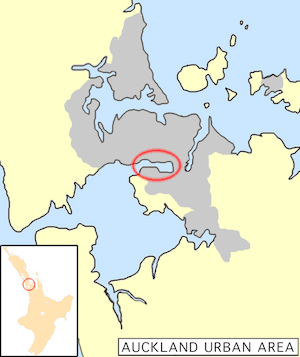Mangere Inlet facts for kids
The Mangere Inlet is an arm of the Manukau Harbour, which is one of Auckland, New Zealand's two main harbours. The Manukau Harbour itself is part of the Tasman Sea. This inlet sits between the cities of Auckland City and Manukau City. It covers an area of about 6.6 square kilometers and collects water from a larger area of 34.5 square kilometers. It stretches west towards Onehunga, where a port is located.
Humans have changed the Mangere Inlet a lot, especially the northern shoreline. However, it also naturally collects dirt and pollution, which means it can easily become contaminated.
The inlet is surrounded by suburbs like Te Papapa, Southdown, Westfield, Ōtāhuhu, Māngere East, Favona, and Māngere Bridge. At Ōtāhuhu, Auckland is at its narrowest point. Here, the Mangere Inlet is only about 1200 meters away from the Otahuhu Creek, which flows into the Hauraki Gulf.
The Mangere Bridge crosses the western end of the inlet, connecting it to the main part of the Manukau Harbour. At this point, the inlet is about 750 meters wide. The Waikaraka Cycleway is a path for bikes that runs along the northern side of the inlet. Ngarango Otainui Island is a small island located in the eastern part of the inlet, near Ōtāhuhu.
History of Mangere Inlet
Portage Road was a very important path in the past. It was one of the overland routes that connected the Manukau Harbour (which leads to the Tasman Sea) with the Hauraki Gulf (which leads to the Pacific Ocean). Māori people would carry their waka (canoes) across this land, avoiding the long and dangerous journey around Cape Reinga. This made the area very important for travel and trade, both before and after Europeans arrived.
In the 1850s, after European settlers came, the land around the inlet became a major farming area for Auckland. Later, as industries grew and moved west from the new railway line at Westfield, more and more waste was released into the inlet.
Environment of Mangere Inlet
The Mangere Inlet has been greatly changed by human activities. For example, three smaller bays along the northern shore, which were once inlets for streams, have been filled in. Much of this land was used for landfills, where rubbish was buried. Also, the Hopua volcanic crater, which forms the Onehunga Basin further west, no longer gets regular tides. Ann’s Creek in the north-east still has a short section of open stream. In the 1960s, land was also reclaimed (filled in) for the Westfield Rail Yards, making the inlet smaller in the east. The southern shore has been changed less.
The waters of the inlet are generally quite muddy and full of sediment. This seems to have been the case even before people lived here. You can find mangrove swamps along most of the shoreline, though they become less common west of Mangere Bridge.
For many years, various industries in the area, such as meat processing plants and factories making phosphate fertilizer, released a lot of untreated waste into the Manukau Harbour. This caused a lot of damage to the harbour's environment. At the start of the 1900s, the harbour was a popular place for swimming, sailing, fishing, and collecting shellfish.
By the 1950s, the breakdown of organic waste, including from homes and places like Middlemore Hospital, caused bad smells and turned lead paint black in nearby areas. However, things started to improve in 1962 when the Mangere sewage works began operating. This facility removed much of the household and industrial waste that was previously dumped into the water.
Even with these improvements, some industrial sewage still mixes with stormwater overflows. This, along with other pollution, means that mussels and oysters tested in the area still show higher-than-average levels of toxins like pesticides, insecticides, PCBs, and copper.
Images for kids




